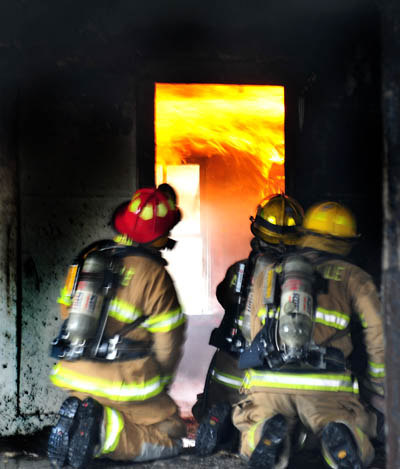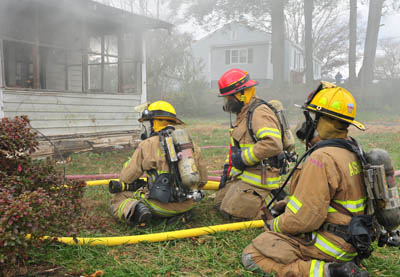Somewhere out there in the big garage of Fire Station 10 in West Asheville, there’s a firefighter down. His high-pitched, personal-alert safety system is screaming, meaning either that he activated it or he’s not moving. Either way, he needs help.
 |
| A rapid intervention team finds the target of their search — this time a mannequin stand-in for an injured firefighter — and assess the situation. |
This is a job for the rapid-intervention team: the worst-case-scenario crew, the ones who rescue the rescuers. At the front, a navigator carries a rope bag connected to something outside. Next comes a searcher with an infrared camera, then the air carrier. Bringing up the rear is the person with the gear.
Moving as a unit, they enter the space, searching left and right. Once they find the down firefighter, the navigator ties off the rope so they can find their way out — and others can find them. The searcher and the air carrier evaluate their colleague, untangle him and give him a new mask and a full tank of air.
If the firefighter is able, they walk out as they came in, following the tied-off rope. Otherwise, they drag their colleague along the rope. No two firefighters will empty their tank at the same rate. Add in stress, injury or even damage to the respiratory system, and things can turn critical real fast. Meanwhile, the alarm is making an unbelievable racket in the enclosed space.
The last exercise involves getting to the firefighter through a 14.5-by-20-inch hole and getting him or her out through the same hole — all before any team member runs out of air.
The next day, they repeat the drill, only this time, they’re blind-folded, with instructors and co-workers using various tricks to confuse them. Each time they come to a situation they can’t identify, they’re supposed to call “mayday,” activate their alarm and wait for help.
Over the last several months, every member of the Asheville Fire Department has been through this training. “As a firefighter, you have to overcome your fear of what you think is going to happen and rely on your training and experience to do what has to be done,” says Chief Scott Burnette.
But this is no mere abstract exercise. It’s been nearly a year since the tragic July 28, 2011, arson fire at 445 Biltmore Ave. that claimed the life of Capt. Jeff Bowen (see sidebar, “Making a Difference”). Since then, the department has been exhaustively evaluating itself: its training, systems and culture.
“We’ve formed 17 different committees to look at every aspect of not only that day, but the day before and the days after,” Burnette ex-plains, adding, “We work on the arson case every single day.”
Only a drill — this time
 |
| Asheville firefighters prepare to tackle a training blaze in a house on Alabama Avenue. Temperatures in room fires like this one range from 400 to 800 degrees F. |
The Fire Department fields more than 15,000 calls a year — 4,500 out of the downtown station alone. That makes for a lot of sirens in the streets. All told, the AFD has 12 stations around town plus a variety of trucks and gear, some of it highly specialized. You wouldn’t want to tackle a chemical fire with what you use to fight forest fires, and scuba gear isn’t much use on a 5,000-foot ridgeline.
Most of the work, though, plays out in the city’s neighborhoods; some, like the fire-prevention efforts and fire marshal’s office, is pretty routine. Every day they’re out there enforcing city regulations, installing car seats, checking fire hydrants and talking to groups about fire safety. Agreements with neighboring fire departments — for sharing specialized equipment, coordinating joint responses, or providing training and support — give the AFD regional reach.
All but two of the agency’s 222 employees are firefighters. They handle all the administrative tasks, the planning, the training and the endless rounds of maintenance. Firefighters spend their days making sure all the equipment is good to go when the alarm sounds. Some days they’re off-call for rapid-intervention or other training, all coordinated from downtown through the training chief.
“We have an amazing pool of talent in this department, just like in this city — really fantastic people who get things done,” says Burnette.
Maximum safety
Asked if there’s some particular building or event in Asheville that keeps him awake at night, Burnette laughs, saying, “Oh yeah: all of them. Seriously, though, Asheville has the oldest housing stock in North Carolina. Our average date of residences is 1964 as opposed to, say, Cary, with an average of 1995. It makes a difference.”
Making a difference |
|
A fund has been established to help the family of Capt. Jeff Bowen, who died fighting a fire last July. To make a donation, go to http://www.captainjeffbowen.com. The site is maintained by union volunteers, and all money collected goes to the Bowen family. You can also send a check to: To learn more, call (828)252-2346. On Aug. 15, the Smoky Park Bridge in Asheville will be renamed in Bowen’s honor. |
Staffing and salaries are also key concerns. “We haven’t been able to hire as many firefighters as we’d like, or to give raises to the ones we have, which is a reality of the times,” the chief observes. With no cost-of-living increase since 2008, firefighters and police officers recently took their pay concerns directly to City Council, which approved a 2 percent increase June 12. Depending on sales-tax revenues, the raise could expand to 3 percent in the fall.
“We’re losing younger guys to bigger departments that start at better money than they’re getting here,” Burnette notes. “We train them, break them in and off they go. Not a lot, but enough to hurt.”
Still, the department is in the process of filling 26 positions, the biggest group hired in a decade or more. There were 604 applicants, and 265 of them were interviewed, Burnette reports.
But even then, only about half the city’s trucks will meet the National Institute of Standards and Technology’s suggested crew size of four firefighters per truck, he notes; the rest will be left with three per truck. A recent landmark study by the institute found that having a fourth firefighter enables the team to perform essential fire-and-rescue operations 25 percent faster than a three-person crew.
“We want this level of service for the safety of the people of Asheville,” says Burnette. “We’ll keep working toward this goal.”
The weight on the chain
One of those applicants was Stratton Tedesco, whose link to the profession runs deep. “My great-grandfather and grandfather were fire-fighters in Tampa; my father was a captain in the Hillsboro depart-ment,” he explains, adding, “I guess it’s just something I need to do.”
Tedesco’s father and brother (then a high-school senior) were killed in an ultralight-aircraft accident in 2009. To help clear his head, he wrote a book about his family’s life in firefighting. Titled Letters of Relief, it’s due out later this year.
Stratton and his mother, Maureen Tedesco, knew they had to get away from the memories, and Asheville was the first place they both agreed on. “It’s been good for both of us, a great and welcoming place, and I am thrilled that he might get into the AFD,” she says. Having passed the written test, the physical and the first interview, Tedesco hopes to be among those hired.
As Tedesco went through basic fire training at A-B Tech, his father and brother were always with him, on dog tags imprinted with their pictures. “Every time I ran, they got there ahead of me,” he says. “When things were tough, that tinkle of metal reminded me that I was not alone; the weight of them on the chain was always there.”
Looking toward the future
But whoever ends up making the cut this time, it won’t eliminate the need for more applicants in years to come, a fact the department is well aware of and is taking steps to address.
“Doesn’t matter how they get here,” says Battalion Chief Doug Zuendt, referring to the AFD’s free summer Fire Escape camp. “We get them here and they have so much fun, they want to keep coming back.”
This year’s camp attracted 28 kids from as far away as Horse Shoe in Henderson County: a record. Some had previously attended a shortened version of the program at the Asheville YWCA, or the Asheville City Schools’ In Real Life after-school program, notes Zuendt, who oversees most of the department’s youth educational programs. The only complaint they hear from parents and kids alike is that the camp, now in its third year, isn’t long enough.
Another program run with an eye toward the future is Asheville Fire Explorer Post 77, which trains teens and young adults in firefighting skills.
As for what it takes to do his job, Zuendt says: “You should have a little more heart, or drive, or something if you want to be a firefighter. It’s not just something you do for the paycheck.”
“After we watch them all those years, it will be easy to hire them as firefighters, if that’s what they want,” he continues. “Our short-term goal is for the kids to have a good time. Our ultimate goal is for them to be aware of what the people in the fire service do, and support that however they can. If they want to [work for] Asheville Fire, great. If they’re businessmen sitting around in a café someday while a fire truck goes by, they’ll have some insight.”
“I love these kids,” Zuendt declares. “They tell me some are ‘at risk.’ I don’t believe that: They just need some direction.”
Lingering questions
But even as his department looks to the future, the past remains very much on Chief Burnette’s mind, as the committees painstakingly analyzing last year’s tragedy prepare to deliver their conclusions.
“Every day, someone takes a look at where we are and tries something new,” says Burnette. Nationwide, only about 15 to 20 percent of arson cases are ever solved.
“The reports are due in the next month or so, and I’m looking forward to seeing what they say,” he reveals.
 |
| A backup hose team awaiting orders to go into a fire. |



Before you comment
The comments section is here to provide a platform for civil dialogue on the issues we face together as a local community. Xpress is committed to offering this platform for all voices, but when the tone of the discussion gets nasty or strays off topic, we believe many people choose not to participate. Xpress editors are determined to moderate comments to ensure a constructive interchange is maintained. All comments judged not to be in keeping with the spirit of civil discourse will be removed and repeat violators will be banned. See here for our terms of service. Thank you for being part of this effort to promote respectful discussion.